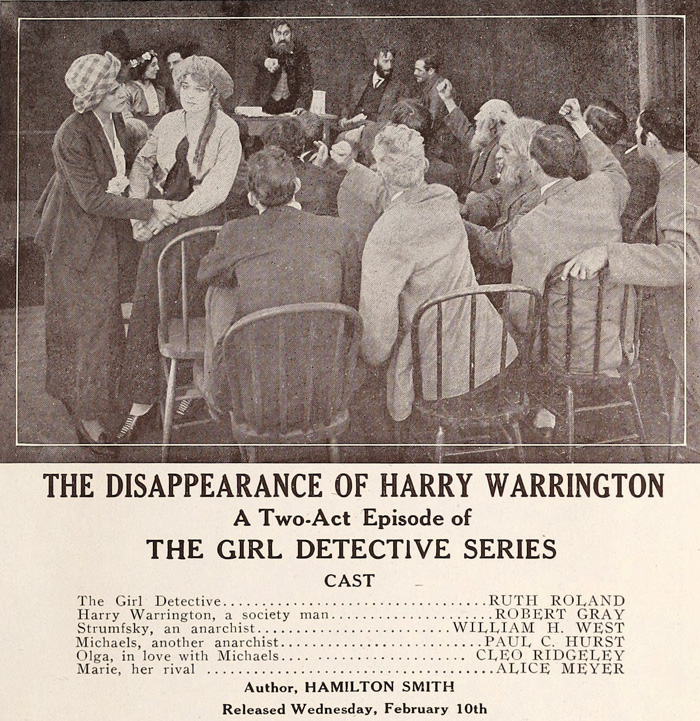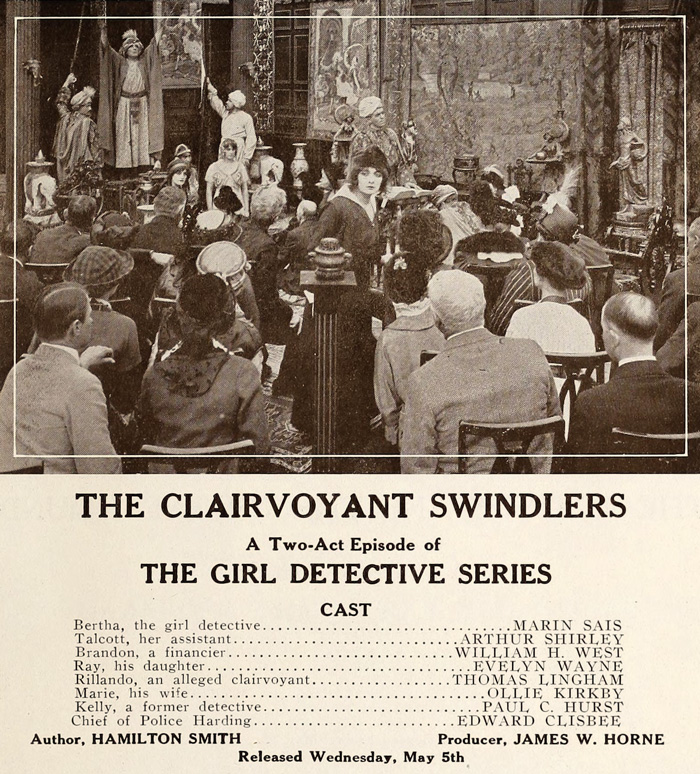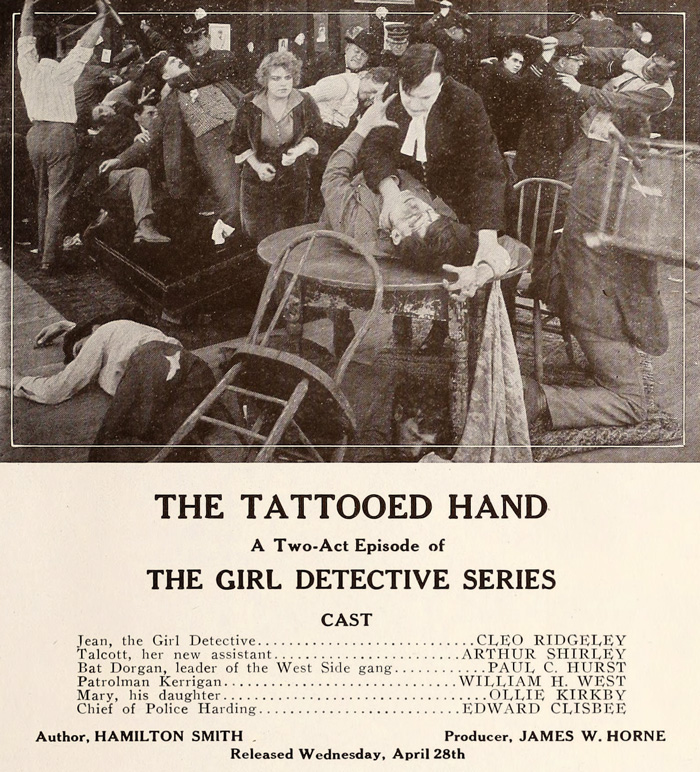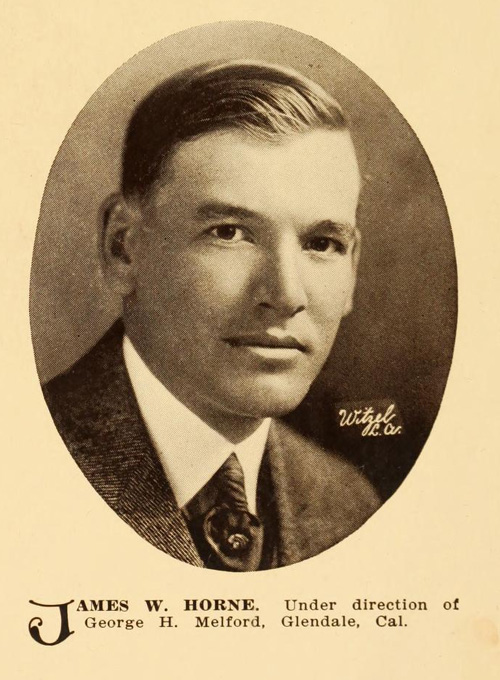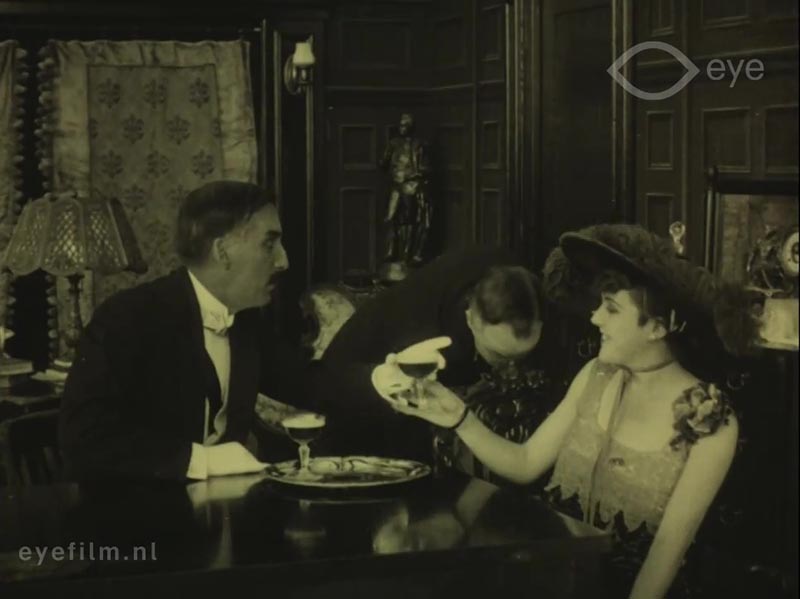Ruth Roland’s fourth outing as the Girl Detective features her attempts to rescue a debutante from the nefarious dancing master who has kidnapped her. All the action-adventure and mystery goodness we have come to expect from 1910s cinema.
Home Media Availability: Stream via EYE.
I just like typing “Marmaduke”
Moviegoers have always loved a good mystery, so it’s not surprising that the Kalem film company chose to launch a series of two-reelers starring the spunky Ruth Roland in 1915. The series outlasted Roland’s stint at the company and ended up with eighteen entries before being abandoned but it fits neatly into the 1910s craze for women action stars.
When silent serials were remade, spoofed or referenced in the mid-century, they often reworked the heroines into damsels in distress but real 1910s serial queens went toe-to-toe with the boys and if they ended up in peril, it was a mere speedbump in their adventures. (You might compare them to James Bond—often in mortal peril but always the focus of the story and not a living plot device to be rescued.)
The Mystery of the Tea Dansant was Roland’s fourth outing as Ruth, the Girl Detective, and it gets right down to business. Ruth is hard at work at the police station, having solved yet another case. Meanwhile, Marguerite Wheeler (Cleo Ridgely) arrives as Marmaduke’s (Thomas Lingham) dance academy to take lessons. Marmaduke is in financial straits, so he decides to kidnap Marguerite and hold her for ransom.
Ruth is on the case and has Marmaduke’s assistant, Darby (Knute Rahm), arrested. Darby has no great love for his boss as Marmaduke left him holding the bag during a previous criminal undertaking and he agrees to help. Marguerite is still being held at the dance academy, so Ruth heads out to rescue her with the aid of Darby and Harry Warrington (Robert Henry Grey), her assistant.
It’s a lot going on in a single two-reeler and it includes a flashback to Marmaduke and Darby’s criminal past in an unnamed African country. Fortunately, the direct plot and the efficient direction keep things clear and moving along nicely.
Marmaduke isn’t exactly the model of a criminal mastermind. Who kidnaps someone and holds them at a place of business where they had an appointment? Still, Roland is enthusiastic and the flashbacks to Marmaduke’s earlier treachery add a bit of depth.
The Girl Detective is sometimes compared to Nancy Drew (who was, of course, a Girl Detective) but that’s not quite accurate. Drew was a teen who solved mysteries on her own. Ruth Roland played an adult woman who was officially in the employ of the police department, she even had her own office and a badge. The “Girl” description is inaccurate but male leads were regularly called “the Boy” during this period, so it’s far less annoying than, say, calling Torchy Blane a “Girl Reporter” when male leads of the 1930s had all graduated to manhood.
I similarly do not have enormous issues with the climactic scene of The Mystery of the Tea Dansan in which Ruth is briefly overpowered by Marmaduke before her backup arrives. Ruth takes a moment to recover and then continues to perform her duties. The hero of The Deputy’s Peril (1912) similarly took time to deal with his brush with death, so I don’t take this as a sign of weakness. More that as action movies went on, the male heroes became more and more unrealistically hard and any sign that they were stressed or dealing with emotions other than anger was considered sissy stuff.
The Girl Detective’s official status and access to all the powers that go with it is significant. She’s not a kid or a reporter or a talented amateur who has to sneak into the law enforcement game. She is treated as an equal by her co-workers and the lack of “oh no, here’s that annoying amateur again” scenes is refreshing. She’s a detective who happens to be a woman and that’s how the narrative treats her. Some modern movies could learn a thing or two.
Most of the series entries are unaccounted for but, fortunately, Kalem published detailed synopses to market the pictures and they are pretty accurate when compared to the entries I have seen. The series kicked off in January of 1915, with The Affair of the Deserted House, introducing Ruth Roland as a debutante who has taken to solving mysteries in order to amuse herself. The police are so impressed by her skills that they hire her at the end of the short. The third entry, The Disappearance of Harry Warrington, features Ruth rescuing a well-heeled kidnapping victim, a naïve would-be socialist whose attempts to help the poor lead to him being abducted by anarchists.
Harry himself joins police force as Ruth’s assistant and he acts as her muscle, undercover partner and dude-in-distress for his entire run in the series. Near the end, Harry’s perils become more and more baroque with the poor man trapped in a flooding basement with giant rats at one point.
Cleo Ridgely was another regular. She played assorted victims and molls in the Ruth Roland entries before being promoted to the title character after Roland departed. She would later marry series director James W. Horne, so there was a method to the casting madness. Ridgely was presented as an up-and-comer at Kalem, with breathless descriptions of her beauty mixed with dubious claims that she had been briefly kidnapped by Mexican rebels. It’s a living.
The Girl Detective would have been very much considered a step in a film career, not a career in itself. And so, Roland made seven pictures in the series before joining the ranks of Pathé’s serial queens and she was replaced by Cleo Ridgely, who played “Jean, the Girl Detective” six times. Ridgely landed a job at the Paramount lot and Marin Sais stepped into the series as “Bertha, the Girl Detective” for three episodes. Likewise, Robert Henry Grey departed halfway through Ridgely’s run and his Harry Warrington was replaced by Arthur Shirley as “John Talcott, her new assistant.”
I am very curious to know how the switches in both actress and character were handled. Was there a “Oh, by the way, Ruth got married, meet Jean” title? Or did Jean just show up at Ruth’s office and with Ruth’s assistant and everyone just went with it? Unfortunately, the only entries available seem to be the one we are reviewing today and Old Isaacson’s Diamonds, another Roland entry.
(Incidentally, Ridgely found herself the recipient of a good, old-fashioned showbiz opportunity when Cecil B. DeMille’s original leading lady for The Golden Chance showed up for work drunk. DeMille named no names but had to find a replacement quickly and Ridgely was it. The picture is one of DeMille’s best from 1915, a gritty Cinderella story with social justice bent and a less-than-optimistic ending. If you only know DeMille from his opulent and bonkers religious epics, do give this one a shot.)
With its light continuity, short length (two reels) and episodes released every Wednesday, The Girl Detective can almost be considered a television series before television. There were eighteen films in the series with the three different lead actresses and two different supporting male characters, all directed by James W. Horne.
- The Affair of the Deserted House (Roland, January 27, 1915)
- The Apartment House Mystery (Roland, February 3, 1915)
- The Disappearance of Harry Warrington (Roland and Grey, February 10, 1915)
- The Mystery of the Tea Dansant (Roland and Grey, February 17, 1915)
- Old Isaacson’s Diamonds (Roland and Grey, February 24, 1915)
- Jared Fairfax’s Millions (Roland and Grey, March 3, 1915)
- Following a Clue (Roland and Grey, March 10, 1915)
- The Trap Door (Ridgely and Grey, March 17, 1915)
- The Diamond Broker (Ridgely and Grey, March 24, 1915)
- The Writing on the Wall (Ridgely and Grey, March 31, 1915)
- The Thumb Prints on the Safe (Ridgely and Grey, April 7, 1915)
- The Voice from the Taxi (Ridgely and Grey, April 14, 1915)
- Mike Donegal’s Escape (Ridgely and Shirley, April 21, 1915)
- The Tattooed Hand (Ridgely and Shirley, April 28, 1915)
- The Clairvoyant Swindlers (Sais and Shirley, May 5, 1915)
- Scotty Weed’s Alibi (Ridgely and Grey, May 12, 1915)
- The Closed Door (Sais and Shirley, May 19, 1915)
- The Figure in Black (Sais and Shirley, May 26, 1915)
(I’m guessing that the brief return of Ridgely and Grey in Scotty Weed’s Alibi was either the result of pictures being released out of order or some pinch hitting to maintain the release schedule.)
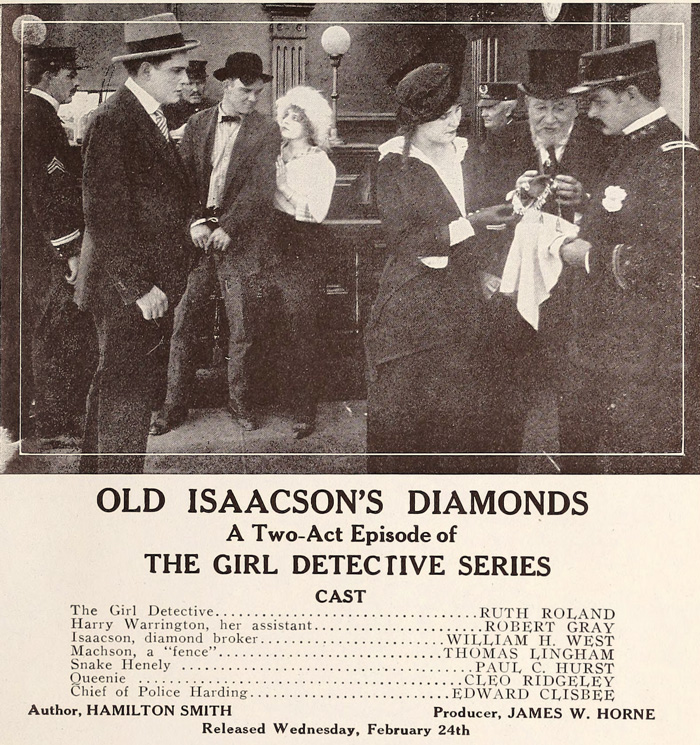
The Figure in Black seemed to be the end of the Girl Detective series. The Secret Well with Sais and Shirley, in which they played totally different characters, replaced the Girl Detective entry in June and Sais continued to play in Horne-directed Wednesday shorts. A few of the titles: The Money Leeches, The Vanishing Vases, The Vivisectionist, The Accomplice, The Frame-up, and The Straight and Narrow Path. The Strangler’s Cord launched a new series for Sais, in which she played a house detective at a hotel.
Director James W. Horne had an interesting history in film. He started at Kalem in the early 1910s and showed an aptitude for directing action, which later morphed into comedy and he is probably best remembered as a regular director of Laurel and Hardy pictures. These talents were combined in his witty production of the 1940 serial The Green Archer, one of the zaniest examples of the genre.
Back in the silent era, Horne helmed The Cruise of the Jasper B (1926) for Cecil B. DeMille’s independent company, which boasted a quarter-million-dollar budget (big movie money in those days) and it remains one of the best kept secrets among silent movie fans. It features madcap and almost surreal humor and a plot that revolves around a last will and testament transferred to the bare back of Mildred Harris. If you have not seen it yet, make plans to do so because it must be seen to be believed.
Unfortunately, and likely on the strength of The Cruise of the Jasper B, Horne was engaged to direct College with Buster Keaton. Keaton did not care for Horne at all and in Kevin Brownlow’s The Parade’s Gone By… (1968), he declared Horne to be useless, that he had made few pictures and no important ones. In spite of the fact that Brownlow mentioned The Cruise of the Jasper B by name, thus providing a very good reason why Horne was hired, later authors quoted Keaton without the context or pushback and the notion that Horne was a no-talent amateur has clung to him.
Incompatibility with a big star is not a crime (most of classic Hollywood would be in jail—from Keaton alone!) and it’s a shame that some historians have bothered to check out Horne’s extensive early work and especially The Cruise of the Jasper B. From what I have seen, Horne was a capable, unpretentious director who kept the action moving and knew how to mine a gag for laughs. He wasn’t flashy but he got the job done and his sly sense of humor allowed him to work in the action genre with a plausibly deniable tongue-in-cheek.
In fact, the two available entries in the Girl Detective series show Horne improving by leaps and bounds. Old Isaacson’s Diamonds was released directly after The Mystery of the Tea Dansant and it shows considerable improvement in framing, cinematography and editing. It’s easy to see why he was in demand for this genre.
This situation is a valuable reminder to us all that a single wrong impression—whether it was intentional or not, malicious or not is immaterial—can cause a great deal of harm if it is repeated. (See also: “Mabel Normand was a bad director who got the job via the casting couch” belief perpetuated in many silent film histories and the motion picture Chaplin.)
The Girl Detective series is unpretentious fun that fit neatly into the taste of its era and, frankly, puts many later portrayals of female action stars to shame. If you’re in the market for a bit of pulpy fun (aren’t we all?) then a good time is waiting for you.
Where can I see it?
Stream for free courtesy of EYE. The subtitles are in Dutch but the story is easy to follow.
☙❦❧
Like what you’re reading? Please consider sponsoring me on Patreon. All patrons will get early previews of upcoming features, exclusive polls and other goodies.
Disclosure: Some links included in this post may be affiliate links to products sold by Amazon and as an Amazon Associate I earn from qualifying purchases.




